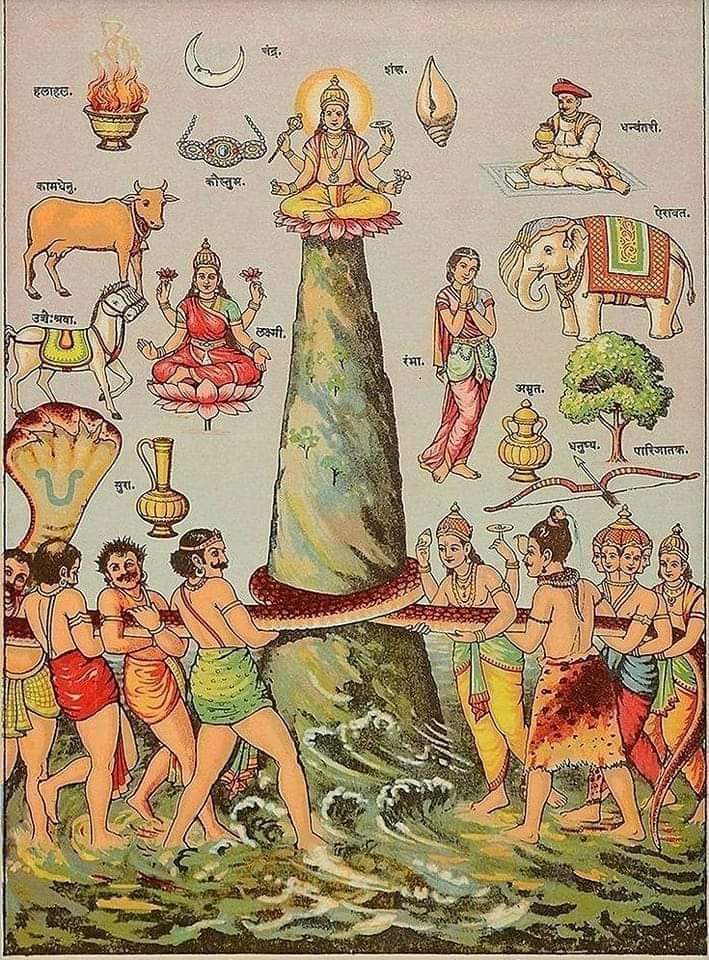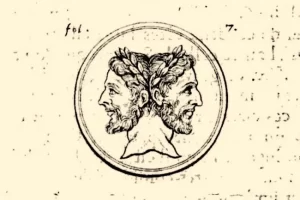The Samudra Manthana is one of the best-known episodes in the Vedic philosophy narrated in the Bhagavata Purana, in the Mahabharata and in the Vishnu Purana.
The story of the Samudra Manthan symbolises the spiritual endeavour of a person, trying to achieve self-realisation by concentrating his mind, withdrawing his senses, controlling his desires and practicing severe penances.
The Devas and the Asuras represent the positives and negatives of one’s own self. It represents how, to achieve self-realisation, one must control both sides of his self and balance them in order to reach the goal.
The Mandhara Mountain (Mana – mind; dhara – in one line or flow) symbolises concentration.
Vishnu’s Kurma Avatar – symbolises the withdrawal of one’s senses – just like a tortoise retracts its head under its shell. It symbolises contemplation through meditation and concentration.
Vasuki – the serpent king – was used as the churning rope, and it signifies the desire to attain the nectar of immortality. It’s as if the Devas and Asuras, churned their mind with a rope of desire.
The Ocean of Milk – is the collective human consciousness or the mind.
The Halahal poison – represents the suffering and pain that comes to the fore when one goes through severe penance.
Thus as of now, here’s how it stands; As the Devas and the Asuras (the positives and the negatives of one’s self), churned the ocean of milk (the mind) for the nectar of immortality (self realisation), with Mount Mandhara (concentration) resting on Vishnu’s Kurma Avatar (withdrawing their senses), using Vasuki (desire) as the churning rope, the first thing that came out, was the Halahal poison (pain and suffering) which had to be resolved for further progress.
The precious objects that came out of the ocean of milk represent the psychic or spiritual powers that one is rewarded with, after he continues his penances, having resolved pain and suffering. The Devas and the Asuras distributing these gifts of the oceans symbolises that one needs to use these gifts for common welfare and not for one’s personal gains. Only then, could they progress in the epic churning project.
Dhanvantari symbolises health – implying that immortality (or to be more pracitcal, longevity) or in this case, self-realisation can only be obtained through a state of health. The body and mind must be in a state of perfect health for the attainment of this goal.
Mohini – is symbolic of delusion or pride. Once they were very close to their goal, the Devas and the Asuras succumbed to their pride and were deluded. They were thus, led astray. Thus, pride must be overcome before the final truth is attained.
The Amrit or the nectar of immortality that is finally obtained, is symbolic of self realisation, after one has give up his/her pride.
Halahal or Kalakoot (the all-consuming poison): The first thing that evolved from the churning was an all-consuming, supremely powerful poison called Halahal, which gave off such poisonous fumes that both parties began to die from asphyxiation. Where Lord Shiva consuming the poison, symbolises that to resolve the pain and suffering that has resulted out of severe concentration and penance, one needs the qualities of Lord Shiva himself: courage, compassion, willingness, initiative, simplicity, austerity, detachment etc.
The poison is symbolic of all that is unknown, lethal and dangerous in the oceans. Even today, man has not completely conquered the ocean, my interpretation is that the Vedic texts attempted to convey this same message to mankind. Only Lord Shiva holds the power to survive this poison, so he drinks the poison, which starts to have its devastating effect on Shiva.
Witnessing this condition, his wife, the Goddess Parvati places her hand on his throat, and as she is an anthropomorphic representation of Nature, she is successful in localizing the poison’s effects to Shiva’s throat. This is meant to show the love and understanding between a couple. Shiva-Parvati represent the ideal couple, and hence, this is a symbolic reference to their mutual love, respect and concern for each other. Because of this, Shiva’s throat turns blue, and he is also known as Neelkanth (Sanskrit: Neel=blue, kanth=throat)
Following this, 13 gems or Ratnas emerge from the churning, some of them have symbolic insight. (Halahal is considered the first Ratna in some versions, making the total up to 14).
Lakshmi: The Goddess of Wealth, who accepts Lord Vishnu as her consort. It is very fitting that she emerges from the ocean. Even today, we know that the ocean contains vast, unsurpassed reserves of gold, silver, gems, oil, natural gas etc.
Apsaras (divine nymphs): They are taken up by various demigods as consorts. Some comparative history research suggests these are the equivalent of mermaids. No reference in Hindu texts that remotely indicate any such features to the Apsaras, except that both species are known to be very good singers.
Varuni: Represents the tempestuous mood of the oceans, she was taken up (somewhat reluctantly) by the demons. However, in some versions of the story, Lord Varuna (the Hindu God of the Oceans) accepts him as his consort.
Ucchaishravas (the seven-headed horse): This is the equivalent of Pegasus. Ucchaishravas is considered as the king of horses (mankind has always seen horses as a symbol of power, strength and virility) and is taken by Indra, the King of Gods.
Kamadhenu: A divine cow, that grants its owner any wish. Kamadhenu is symbolically related to the form of Devi (the all-giving Mother). She is taken by Lord Vishnu and granted to sages so that the ghee that comes out of her milk can be used for the highest sacrificial offerings. she may also be closely related to the fertility goddess Prithvi (Mother Earth), also sometimes mentioned as a cow in Hindu texts.
Kaustubh: The most resplendent of all jewels, which was so beautiful that the demons and gods started quarreling among themselves as to who would have it. Kaustubh represents the all-consuming greed that can emerge so effortlessly and easily from something beautiful and precious.
This gem is finally worn as an adornment on his chest by Lord Vishnu, because only he is completely detached from the greed associated with riches (because Lakshmi, the Goddess of Wealth is his consort: See how it ties up)
Parijat: A divine, magical tree that has blossoms which give out a sweet perfume. This tree has been identified as Nyctanthes arbor-tristis and research has indeed shown that this tree has medicinal properties. Parijat was taken up by the Gods.
Sharanga: A divine bow emerging from the oceans, symbolic of weapons that can be created from the ocean’s unknown. It is an established fact in Vedic texts that the Sharanga is the most powerful bow (Vishnu once battled Shiva, who also used his bow Pinaka, but was able to successfully defeat Shiva, almost stunning him with his torrential downpour of arrows). Sharanga represents the latent power of the ocean which could be used for creating something as destructive as a divine weapon.
Kalpavriksha: Often mistaken for Parijat. Note that the original legend explicitly mentions the emergence of two distinct trees. Subsequent alterations tend to merge these trees as one. Alternatively called as Kalpataru.
This tree is recorded to give boons to its worshipers, fulfilling their wishes. Even Gods are not exempt from the benefits of this tree. Symbolically speaking, the tree represents Mother Nature and how she holds the potential of controlling certain aspects of even divinity!
Chandra (the moon): Emerges from the ocean and finds place on Lord Shiva’s forehead. At the time of the legend, the Indo-Aryans had some inkling that the patterns of the moon influences spring and neap tides. This is somewhat reflected through the moon emerging from the cosmic ocean. The Milky Way represents this “cosmic ocean” and so it makes sense that the moon emerges as a proper subset of the Milky Way.
Jyestha (the Goddesses of misfortune): In some versions, called as Alakshmi (the opposite of Lakshmi, who is the Goddesses of fortune). Taken up by the demons, she represents the polar equivalent of Lakshmi.
Dhanvantari + amrita: The final result of this churning is the emergence of Dhanvantari, who is then appointed as the Physician of the Gods. He emerges with a kalash (a metallic pot or vessel) that contains amrita, the drink of immortality.
The demons chase him and manage to snatch the pot of immortality, but then quarrel among themselves. The Gods immediately rush to Lord Vishnu to help them.
Lord Vishnu, realizing that evil cannot be made immortal, incarnates into Mohini, a supremely beautiful lady, who is successful in enticing the asuras. Mohini suggests that she divide the drink equally between both parties. Except that she uses Maya (illusion) to swap vessels every time she serves a demon, thus ensuring that evil does not become immortal.
When one of the clever demons himself uses illusion to make him look like a God and drinks the elixir, Mohini reincarnates to her true form as the God Vishnu and uses his serrated discus called the Sudarshan Chakra to cut off the demon’s throat. However, the head (Rahu)of the demon, which had drunk the elixir becomes immortal. The story of the Samudra Manthan has multiple symbolic messages, but for me, the most erudite of them all is the fact that Good always triumphs over Evil.
By – Anadi Sahoo
#samudramanthan #Samudra #sea #searching #Manthan #amrit #poison #Dhantryodashi #laxmi #worldwidehindutemples #समुद्र #मंथन #समुद्र_मंथन #विष #कामधेनु #ऐरावत #हाथी #कौस्तुभ #मणि #कल्पवृक्ष #देवी #लक्ष्मी #देवता #समुद्रमंथन #विष्णु #पुराण #hinduism #jaishriram #spiritualgrowth #MeraBharatMahaan




